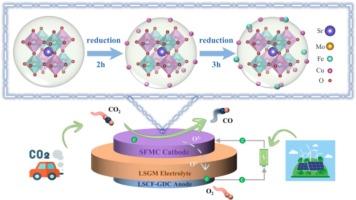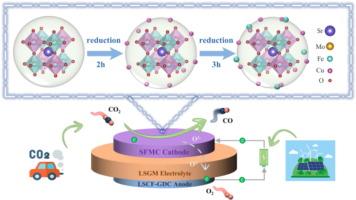Cu或Fe-Cu双金属颗粒在双钙钛矿阴极上的可调溶出,增强固体氧化物电解电池对CO2的吸附和催化活性
IF 9
1区 工程技术
Q1 ENGINEERING, CHEMICAL
引用次数: 0
摘要
固体氧化物电解电池(SOEC)由于其将二氧化碳还原反应(CO2RR)与可再生能源存储相结合的独特能力而受到越来越多的关注。然而,SOEC设备面临的一个关键挑战仍然是CO2RR燃料电极的电催化活性不足和耐久性差。在大多数研究中,直接提出了原位脱出钙钛矿电极,而没有讨论脱出颗粒在还原过程中的可调性。研究了还原时间的控制和特定析出元素的选择对电极电化学性能的影响。通过对Sr1.9Fe1.5Mo0.3Cu0.2O6-δ (SFMC)钙钛矿在800℃下进行一步还原处理,分别在2 h和5 h下,成功地原位构建了外溶Cu金属颗粒(R-SFMC-2 h)和Fe-Cu双金属颗粒(R-SFMC-5 h)的异质结构DP-SFMC复合材料。R-SFMC-2 h和R-SFMC-5 h表现出优异的CO2电解性能。在800℃下,在1.5 V的电位下,CO2电解电流密度分别达到1.73和1.53 A cm−2,明显优于原始SFMC阴极(0.99 A cm−2)和其他有前途的电极的单电池。本文章由计算机程序翻译,如有差异,请以英文原文为准。


Tunable exsolution of Cu or Fe-Cu bimetallic particles in double perovskite cathode for enhanced CO2 adsorption and catalytic activity in Solid oxide electrolysis cells
Solid oxide electrolysis cells (SOEC) have garnered increasing attention due to their unique capability to integrate CO2 reduction reaction (CO2RR) with renewable energy storage. However, a critical challenge facing SOEC devices remains the insufficient electrocatalytic activity and poor durability of fuel electrodes for CO2RR. In most studies, the developed in situ exsolved perovskite electrodes were directly proposed without discussing the tunability of exsolved particles during the reduction process. Herein, the effects of the control of reduction time and the selection of specifically exsolved elements on the electrochemical performance of the electrodes are investigated. The in-situ construction of hetero-structured DP-SFMC composites with exsolved Cu metal particles (R-SFMC-2 h) and Fe-Cu bimetallic particles (R-SFMC-5 h) was successfully achieved through a one-step reduction treatment of Sr1.9Fe1.5Mo0.3Cu0.2O6-δ (SFMC) perovskite at 800 ℃ for 2 h and 5 h, respectively. The R-SFMC-2 h and R-SFMC-5 h exhibited superior CO2 electrolysis performance. At 800 ℃ under an applied potential of 1.5 V, the CO2 electrolysis current densities reached approximately 1.73 and 1.53 A cm−2, respectively, significantly outperforming single cells with pristine SFMC cathode (0.99 A cm−2) and other promising electrodes.
求助全文
通过发布文献求助,成功后即可免费获取论文全文。
去求助
来源期刊

Separation and Purification Technology
工程技术-工程:化工
CiteScore
14.00
自引率
12.80%
发文量
2347
审稿时长
43 days
期刊介绍:
Separation and Purification Technology is a premier journal committed to sharing innovative methods for separation and purification in chemical and environmental engineering, encompassing both homogeneous solutions and heterogeneous mixtures. Our scope includes the separation and/or purification of liquids, vapors, and gases, as well as carbon capture and separation techniques. However, it's important to note that methods solely intended for analytical purposes are not within the scope of the journal. Additionally, disciplines such as soil science, polymer science, and metallurgy fall outside the purview of Separation and Purification Technology. Join us in advancing the field of separation and purification methods for sustainable solutions in chemical and environmental engineering.
 求助内容:
求助内容: 应助结果提醒方式:
应助结果提醒方式:


